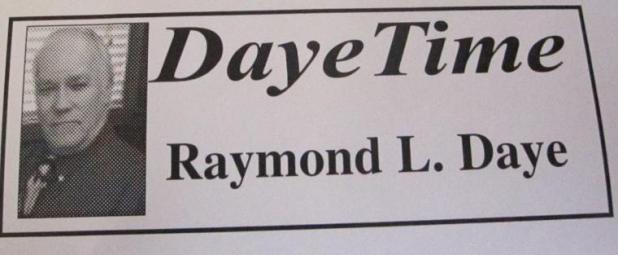
DayeTime: 'Dangerous'
Every year about this time, several online “community rating” sites release their “most dangerous cities” lists for every state in the union. For the past few years, Marksville has been on Louisiana’s list.
The 2020 list, which uses FBI crime report data from 2018, puts the parish seat at No. 4 on the “10 Most Dangerous Cities in Louisiana.”
When these online rankings are released, city officials react by denouncing the ranking as unfair and inaccurate. Interestingly, the author of the crime statistical report -- the FBI -- agrees with that position.
Unfortunately, this year’s online rankings hit computer screens and media email inboxes just as Marksville and other Avoyelles Parish communities were experiencing a string of shooting deaths and injuries, armed robberies and other crimes.
Arguments that this area isn’t as violent as the online rating companies say loses its punch when the headlines tell a different story.
By now you have probably read the “Most Dangerous” article either in the Sunday Journal or online at Avoyelles Today, so I’m not going to repeat the entire article here.
The point of this column is to make a few points as to why this type of comparison should be taken with a heaping tablespoon of salt.
(1) First, and most importantly, because the FBI says so. In its news release on its most recent report, the FBI specifically said the annual statistical report should not be used to rank and compare cities and counties/parishes.
“These rough rankings provide no insight into the numerous variables that mold crime in a particular town, city, county, state, tribal area or region,” the FBI said. “Consequently, they lead to simplistic and/or incomplete analyses that often create misleading perceptions adversely affecting communities and their residents.”
So what happens?
Yep. Communities are ranked and compared based on the FBI statistics.
These reports can’t just be ignored. Anyone from Oakland, Calif., to Auckland, New Zealand, can pull up this list -- and some very snide remarks on some sites -- and immediately conclude there must be gunfights at the Just-All-Right-Corral every night.
We who live in this parish know that isn’t the case -- although we sometimes may think it is.
(2) Another issue is that it does not have information from every law enforcement agency. The FBI said there are almost 18,600 law enforcement agencies eligible to participate in its Uniform Crime Reporting program, but 2,000 failed to do in 2018.
In Avoyelles, the FBI reported it only received information from Marksville, Avoyelles Parish Sheriff’s Office and Moreauville. Moreauville, with less than 1,000 residents, had no reported violent or property crimes for 2018.
In past years, Bunkie and Cottonport showed up on the FBI list, but not in the 2018 stats.
The “Most Dangerous” sites look only at municipalities with at least 5,000 residents.
(3) There is also a concern that these rankings compare “apples to oranges” by lumping Marksville-sized municipalities in with New Orleans-sized cities.
If they even compared oranges to satsumas -- lumping municipalities of roughly the same size together -- they might give a more accurate comparison.
Marksville’s population was estimated at 5,450 when the ranking sites determined the “per 100,000 population” crime rate.
Under the per-100,000 method, a crime would be counted as two crimes in a city of 50,000, one in a city of 100,000, 1/2 in a city of 200,000, etc.
Marksville is the smallest city on the “most dangerous” list. Each crime in Marksville counts as 18.3 crimes. By comparison, New Orleans has a population of about 400,000. That means it would take four crimes to equal one crime per 100,000.
So, for example, in Marksville it would take over 53 crimes to equal one crime in New Orleans.
I don’t think even the Big Easy can catch us with that kind of head start.
It would be interesting to see what the crime rate would be if we treated Avoyelles Parish as a city of 42,000 people. Each crime would only count as about 2.5 crimes.
There would be one police department, five council members, one mayor -- but I digress.
(4) The crime categories are divided into two groups -- violent crime includes only murder/manslaughter, aggravated assault, robbery and rape. Property crime is only burglary, theft and vehicle theft in the report.
The overall “dangerous” ranking is determined by combining violent and property crimes per 100,000.
The rankings do not take into consideration other types of crime, such as drugs, fraud, major traffic offenses, etc.
There is no “point system” to differentiate between taking a life and taking a purse.
(5) This brings up the final point -- that the figures may not be completely accurate. The statistics are for 2018. I know there were at least two homicides in Marksville in a November 2018 shooting that made national news. Yet, the FBI’s statistical report shows no murders in Marksville.
Almost all of the city’s 106 violent crimes were aggravated assaults. There were four robberies, no murders, no rapes.
Maybe those murders will show up in the 2021 “Most Dangerous Cities” ranking, which will be based on the 2019 statistics. If they do, Marksville could climb higher on the “Top 10” list next year.
In short, the statistics may not reflect only a 12-month period. Maybe it’s 10 months for some cities and 14 months for others. I don’t know.
At best, the actual statistical report provides an estimate of crimes in a reporting community. The online ranking report’s best use is for chatting with friends about “did you see that report online.”
It should be noted that online ranking sites also list Marksville as one of the 10 best places to retire in Louisiana, based on low taxes, weather and other factors.
Surely it wouldn’t be considered a good place to retire if it was THAT dangerous.
